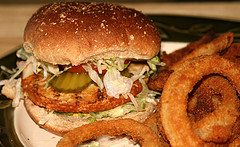Do you realize that not too long ago, “organic” food was just “food”? It’s only been about 60 years since the Green Revolution decided it could do Mother Nature one better, introducing large-scale monoculture, pesticides, herbicides and eventually genetically engineered plants and animals. What used to be simply a tomato is now a designer food, or a political decision, or basic self defense.
Organic food is about much more than just pesticide residue. Take a look at my latest article with Natural News, “Consider Four More Reasons to Buy Organic” for a look at the global implications of your food choices.
I’ve been experimenting with a recipe for cooking dried beans in the solar oven. I’ve found one that I think makes some the best beans I’ve ever tasted. I wrote it up and put it on eHow, so it will reach a larger readership than this blog. If you’re curious, you can find it here. The trick is overnight soaking and then allowing the rising sun to bring up the heat gradually. Not tracking the sun allows the beans to cool slowly in their juices making for a nice tender (but not mushy) bean.
The quality of solar-cooked beans and sweet potatoes alone are are reason enough to get a solar oven. I have a SOS Sport. If you’re thinking of getting one, email me, and I’ll tell you about my experiences with it.
I’m writing these posts–hopefully this will end up being a series–to talk about what I’ve learned about food, weight, health, and what all that has to do with mind and body. It’s a huge topic, but if comes down to something quite simple: Food can make you healthy, or food can make you sick. Food can make you fit, or food can make you fat and sluggish. Given the messy priorities of modern agribusiness, restaurants and food manufacturers who care more about your return business than your health, and the fact that it takes work and skill to eat well, it’s little wonder that we all tend to slide toward poor food and poor health. The first step toward digging yourself out of this pseudo-food quagmire we’re all in is information.
So. . . Important chunk of information number one: If you look at the way that food affects your brain, you’ll see that there are two different kinds of food.
 The first kind of food is real food. Real food is grains, vegetables, meats. If these real foods come with a label–they often don’t–the label simply says “chicken” or “tomatoes” or “rice.” If you look at the ingredients list, it will have one entry and one entry only. When you cook them, you cook them like real people have always cooked real food: you bake them, braise them, stir fry them, boil them, steam them. If you’ve ever done any deep frying, you know why you don’t deep fry them, at least not very often. Deep frying is expensive (because of all that oil that gets used only once or twice), and it’s a pain. It splashes, splatters, drips. It’s tough to clean up after. And then there’s the whole problem of disposing of the oil. Trust me: if you cook from scratch for most meals, you won’t want to mess with deep frying very often.
The first kind of food is real food. Real food is grains, vegetables, meats. If these real foods come with a label–they often don’t–the label simply says “chicken” or “tomatoes” or “rice.” If you look at the ingredients list, it will have one entry and one entry only. When you cook them, you cook them like real people have always cooked real food: you bake them, braise them, stir fry them, boil them, steam them. If you’ve ever done any deep frying, you know why you don’t deep fry them, at least not very often. Deep frying is expensive (because of all that oil that gets used only once or twice), and it’s a pain. It splashes, splatters, drips. It’s tough to clean up after. And then there’s the whole problem of disposing of the oil. Trust me: if you cook from scratch for most meals, you won’t want to mess with deep frying very often.
Your brain on real food looks like this: You’re hungry. You eat the real food. Your brain registers that the food is satisfying. When you are full, your brain says, “I’m full.” In other words, your brain reacts to real food like it reacts to, well, food.
The second kind of food is entertainment food. It’s food with a substantial amount of of at least one, but sometimes all three of the following: sugar, salt, and fat. Think of birthday cake. Sugar and fat. Think of potato chips. Salt and fat. Think of onion blossoms with dipping sauce. Sugar, fat and salt. Most fast food is entertainment food. So are a lot of the prepared foods you find in the freezer section of your grocery story. Read the labels. You’ll be amazed at the amount of sugar, fat, and salt a manufacturer can pack into a small amount of prepared food.
 So why do I call it entertainment food? Because of how your brain reacts to it. Watch your brain on entertainment food. You eat it. Your brain’s pleasure center lights up. “Good stuff,” it says. “I want more.” So you feed it more. How does it respond? “Good stuff,” it says. “I want more.” The pleasure center of your brain shouts down the part of the brain that says when it’s had enough.
So why do I call it entertainment food? Because of how your brain reacts to it. Watch your brain on entertainment food. You eat it. Your brain’s pleasure center lights up. “Good stuff,” it says. “I want more.” So you feed it more. How does it respond? “Good stuff,” it says. “I want more.” The pleasure center of your brain shouts down the part of the brain that says when it’s had enough.
Think of the last time you had, say, fish and chips or pizza. It’s very easy to eat 1000 or even 2000 calories of of these foods. Now think about eating 1000-2000 calories of, for example, a nice hearty bowl of lentil soup. You probably couldn’t do it. Your body and brain wouldn’t let you. Why? Because a different part of your brain is in charge when you eat real food than is in charge when you eat entertainment food. Food is supervised by the food center. Entertainment food is supervised by the pleasure center, the center in charge of drugs, alcohol, and sex. And that part of you brain doesn’t know when to quit.
Now, let’s say you are a food manufacturer or a restaurant owner. You can offer food that is good, nutritious fare, that customers eat in moderation and appreciate. Or you can offer food that lights up a customer’s brain like Vegas at night, that make them always want more, that calls to them a week later. Which one is going to make you more money? Is it any wonder that most of the food available to us already prepared is entertainment food?
Take a look at David A. Kessler’s The End of Overeating. It’s an eye opener. Overeating is only marginally about willpower. It’s mostly about your brain getting used to one long party. As with any party, however, if we live in the party constantly, day in and day out without a break it makes us sick and addicted. It’s true of any of the behaviors that light us up. It’s true of what we eat.
Photos by mikehipp and Emily Carlin. Thanks, guys, for the Creative Commons licensing!
 The New Normal: An Agenda for Responsible Living by David Wann
The New Normal: An Agenda for Responsible Living by David Wann
My rating: 4 of 5 stars
It’s one thing to complain about mega-corps and worry about peak oil; it’s another thing to figure out what to do about it. The New Normal looks at what a sustainable life would look like. It looks at (among other things) food, fuel, health, and possessions. It describes why the current way of living isn’t sustainable, then offers suggestions for what might be a viable “new normal.” In sections entitled “the Heavy Lifting,” Wann suggests ways to get a jump on the change right now. If I had to sum up the book in one phrase, I’d say “a practical look at the big picture.” The tone is a pragmatic, “we have a problem, so let’s stop whining and do something about it.” The writing is a serviceable, journalistic style. The layout is no-nonsense, though maybe a bit cramped, consistent with a book that is more about substance than frills.
View all my reviews
